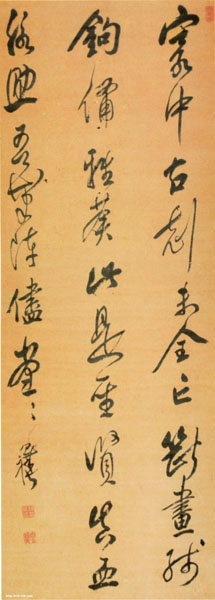Chen Yixi (1648-1709) was born in Haining, Zhejiang. The word Liuqian, Ziwen, Wenyi, the name of Xiangquan, the evening name of Fengsou, Haining Yanguan. Gong Sheng. Born in a famous family, he loved to write poetry books since he was a child. His poem "The setting sun is in the north of the river and the river is in the north, and the Qiushan is in the west of the basin" was praised by Wang Shizhen, the leader of the poetry world. In the thirty-ninth year of Emperor Kangxi of the Qing Dynasty (1700), he was a bureaucrat of the official household department, Datongqiao. Emperor Kangxi passed by and ordered him to board the ship, writing on Sujuan, which was highly appreciated. Although he had no fame in the imperial examination, he was called into the study of Zhinan. Later, he became the prefect of Shiqian Prefecture in Guizhou, and transferred to the prefect of An'an in Jiangxi, where he studied the palace, compiled the official records, and prospered culture and education, and died in his tenure.
Chen Yixi, Wang Shihong, He Zhuo, Jiang Chenying and others are known as the Four Great Masters in the early Qing Dynasty. The calligraphy was based on the Shanxi people, and the special calligraphy was used to win, which had a greater influence among the scholars and scholars at that time. Since the Qin, Han, Tang, and Song dynasties, the collection of texts is particularly rich, all of which are dialectical inscriptions. Diligent and diligent, stably stated in small letters, large-character banners are calm and mellow, and are known as "the authenticity that is not easy to use through the ages", "the contemporary ink is beautiful, and the home is smooth", and it is known as the "fragrant spring style". The emperor of Japan also paid a large sum of money to purchase his works from far and near. The books "Mengmo Lou Fa Tie (梦墨楼法帖)" and "Yuning Tang Fa Tie (予宁堂法帖)" were widely spread. During the Yongzheng period (1723-1735), the "Mengmolou Fa Tie (梦墨楼法帖)" was placed on stone and stored in the inner mansion. He is also a gold and stone collector, collecting a large number of Qin, Han, Tang, and Song gold and stones, one by one dialectical inscriptions and postscripts, compiled as "Yinluxuan Inscriptions (隐绿轩题跋)". He also edited "Wen Hai (文海)" in the style of "Wen Xuan (文选)", collected poetry and essays of the past dynasties, and engraved them in the world. In addition, there are also "Inscriptions on Jinshi Heritage (金石遗文录)", "Chun Ai Tang Collection (春霭堂集)", "Gao Lan Zai Bi (皋兰载笔)", "Feng Sou Inscription Postscript (葑叟题跋)", "Small Name Supplementary Record (小名补录)", "Yizhou Yuyu Ji (益州于役记)", "Bei Jie "Miscellaneous (北解杂述)", "North Travel Diary (北行日记)", "Jinyang Travel Notes (晋阳行记)", "Journey in the Clouds (云中纪行)", "Chen Zi Diary (陈子日记)", "Strange Flowers and Different Woods (奇花异木记)", "Hanxiang New Tablet (含香新牍)", "Autumn Rain House Collection (秋雨斋集)", " "Yuzhou Collection (虞州集)", "Laughing Door Collection (笑门集)", "Green Pavilion Collection (绿荫亭集)", etc.









